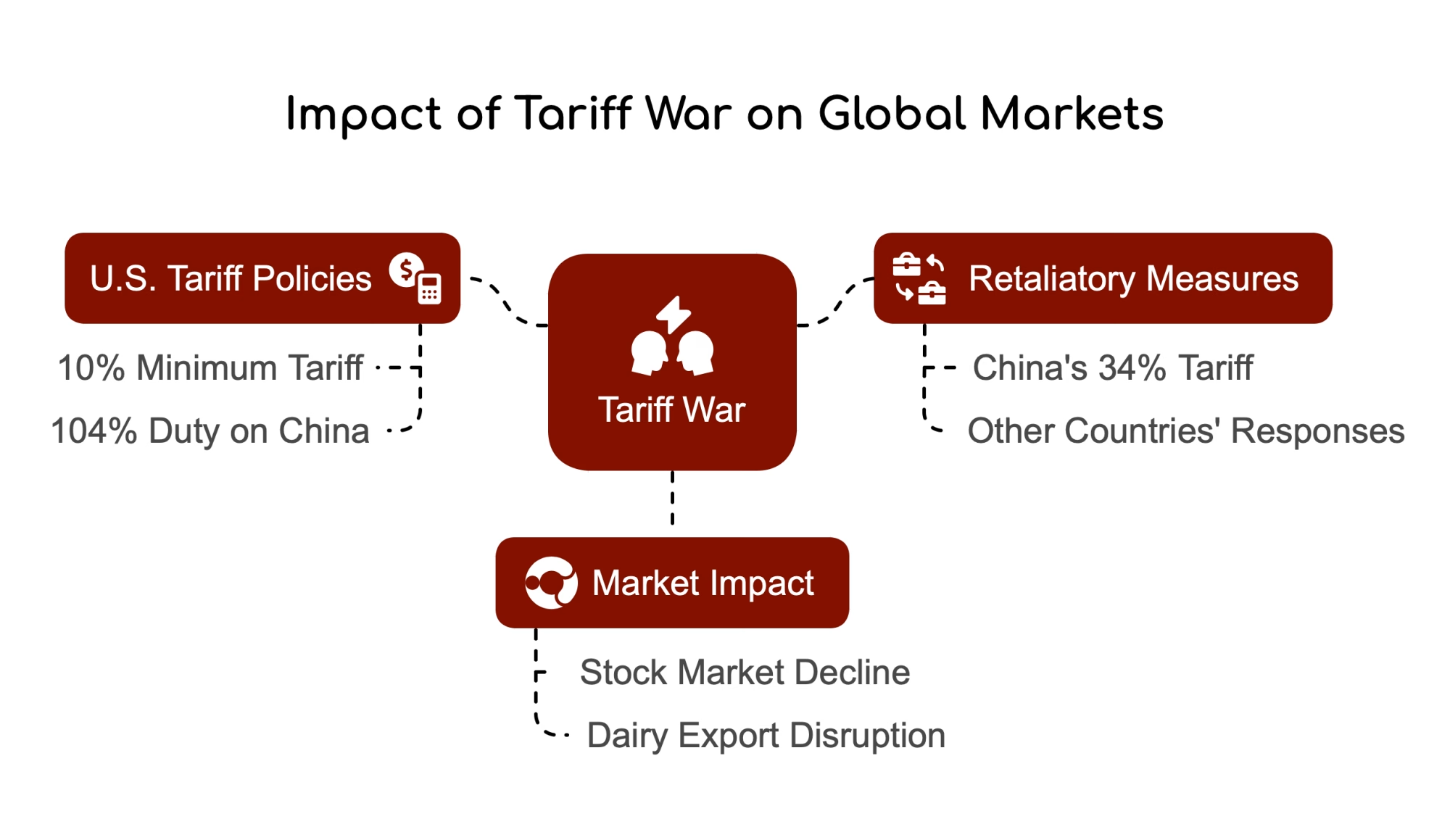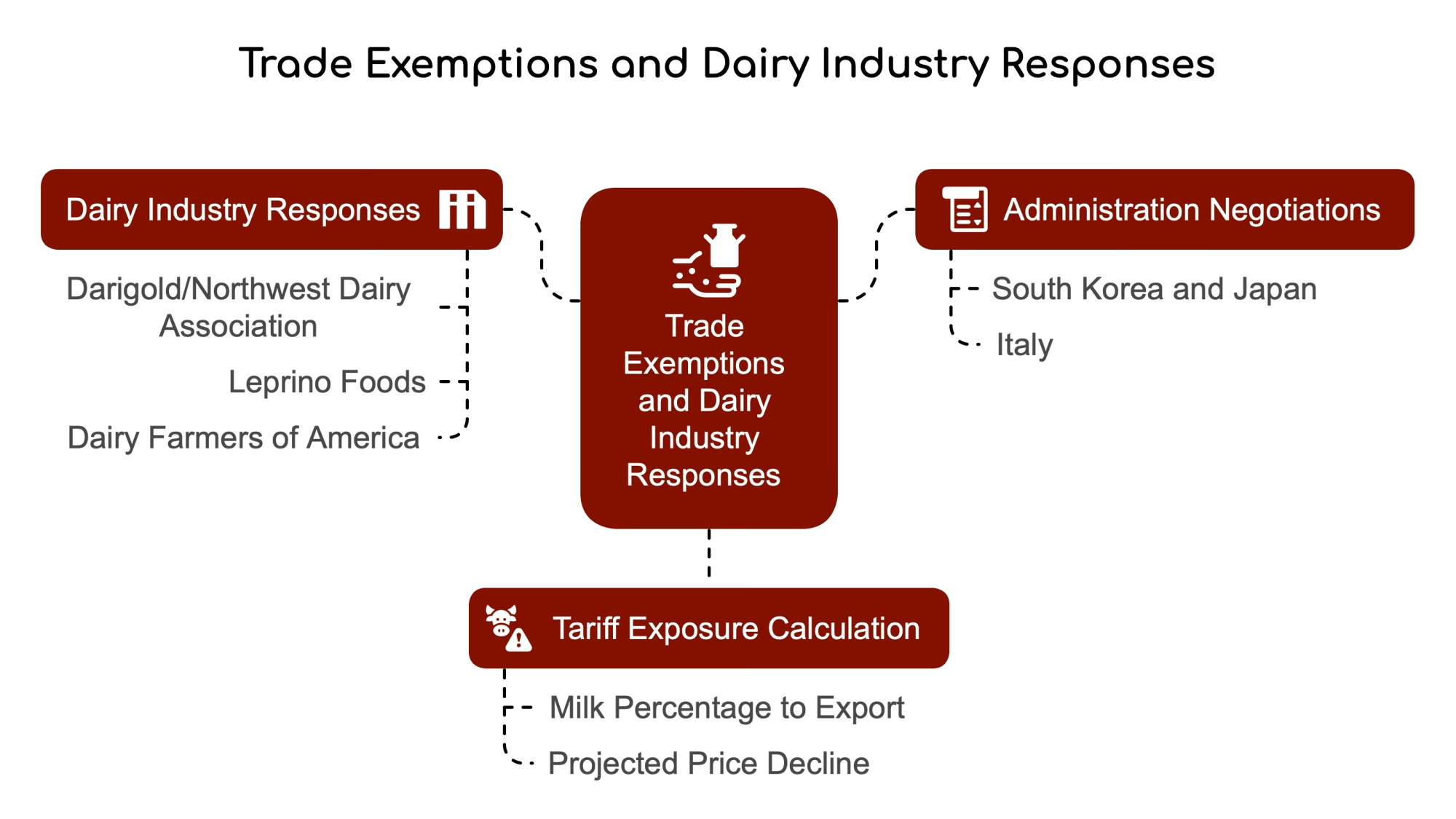Trade war turmoil slashes soybean prices—discover how dairy farmers can cut feed costs now!
EXECUTIVE SUMMARY: The April 2025 WASDE report tightened U.S. corn stocks but revealed a hidden opportunity for dairy producers as soybean meal prices dropped $10/ton amid escalating U.S.-China tariffs. While corn exports rose, soybean demand remains shackled by China’s retaliatory 125% tariffs, creating volatility that masks potential feed cost savings. USDA held South American crop estimates steady despite weather risks, but trade tensions overshadow fundamental data. Dairy operations could save thousands annually by locking in cheaper soybean meal—if they act before Brazil’s harvest or tariff shifts upend markets.
KEY TAKEAWAYS:
- Corn stocks drop 75M bushels as exports offset weak feed demand, stabilizing prices at $4.35/bu.
- Soybean meal prices fall to $300/ton despite higher U.S. crush volume—a $7,500 annual saving for 500-cow herds.
- China’s 125% tariffs on U.S. goods risk soybean market collapse but offer dairy farms rare feed cost relief.
- South America’s crop stability (169M tons Brazil soybeans) hinges on recent rains compensating for early drought.
- Act now: Lock in SBM contracts, optimize rations, and monitor trade talks to capitalize on short-term price dips.

The April 2025 WASDE report just dropped, and buried in all those government numbers is a potential profit bomb for your dairy operation. While corn stocks tightened more than the market gurus expected and this trade war with China has hit fever pitch, there’s good news hiding in plain sight – soybean meal prices are heading down, creating a real opportunity to slash your feed costs. This seemingly dull USDA report contains signals that could make or break your bottom line in the months ahead.
The Hard Numbers: What WASDE Revealed
Corn Balance Sheet Gets Tighter
The April WASDE kept U.S. corn production at 14.87 billion bushels for the 2024-25 crop year but shuffled the demand deck. USDA cut projected feed use by 25 million bushels while boosting exports by a hefty 100 million bushels. This shift knocked ending stocks down to 1.465 billion bushels – a bigger drop than most market watchers saw coming.
Despite this tightening, USDA kept the average farm price at $4.35 per bushel. While supplies shrink, that price stability suggests there’s still enough corn to go around, even with the shifts in who’s buying it.
| Category | Previous Estimate | Current Estimate (2024-25) | Change |
| Production | 14.87 billion bu | 14.87 billion bu | 0 |
| Feed & Residual Use | 5.225 billion bu | 5.200 billion bu | -25 million bu |
| Exports | 2.100 billion bu | 2.200 billion bu | +100 million bu |
| Ending Stocks | 1.540 billion bu | 1.465 billion bu | -75 million bu |
| Season-Avg Price | $4.35/bu | $4.35/bu | 0 |
Soybean Meal: The Hidden Opportunity
Here’s where dairy folks need to pay attention – USDA just knocked $10 per ton off the projected soybean meal price, now forecasting $300 per ton. This price cut comes even as they project more beans to crushers (up to 10 million bushels), which means more meal production (57.3 million tons).
Let’s put that in real terms for your operation: If you’re running 500 cows and using about 1.5 tons of soybean meal per cow yearly, this price drop means $7,500 straight to your bottom line. That’s not chump change when milk prices are squeezing margins.
| Category | Previous Estimate | Current Estimate (2024-25) | Change |
| Soybean Production | 4.37 billion bu | 4.37 billion bu | 0 |
| Crush Volume | 2.300 billion bu | 2.310 billion bu | +10 million bu |
| SBM Production | 57.2 million tons | 57.3 million tons | +0.1 million tons |
| SBM Ending Stocks | 450,000 tons | 450,000 tons | 0 |
| SBM Price | $310/ton | $300/ton | -$10/ton |
Trade War Explodes: What It Means for Your Feed Costs
Unprecedented Tariff Escalation
The backdrop to all this is the trade war that’s gone nuclear. Today (April 11, 2025), China jacked up tariffs on American imports from 84% to 125%. This comes after Trump cranked U.S. tariffs on Chinese goods to 145%. It’s a full-blown economic shootout.
Soybean Market in Turmoil
The American Soybean Association says U.S. soybean growers could lose $5.9 billion annually from these tariffs. Despite this mess, China is expected to import about 3 million tons of U.S. soybeans from April to May.
According to Reuters, over 30 shipments (about 2 million tons) are heading to China in the coming weeks and will get hit with the initial 10% tariff. Another 15 vessels carrying about 800,000 tons are expected to be hammered after May 13, and a 44% tariff will be applied.
South American Production: The Other Wild Card
Weather Recovery in Brazil and Argentina
The April WASDE kept corn and soybean production estimates steady for Argentina and Brazil. USDA says “recent rains have eased concerns” about the dry weather that hit early in the growing season.
Brazil’s soybean production stays at 169 million metric tons, while Argentina’s is at 49 million metric tons. These numbers look stable on paper, but there’s still plenty of uncertainty about whether those recent rains were enough to compensate for the early-season drought stress.
| Country | Crop | USDA Estimate (million metric tons) | Key Risk Factor |
| Brazil | Soybeans | 169.0 | Delayed rainfall recovery |
| Brazil | Corn | 126.0 | Safrinha crop vulnerability |
| Argentina | Soybeans | 49.0 | Persistent soil moisture deficits |
| Argentina | Corn | 50.0 | Late-season frost potential |
Dairy Producer Action Plan: Capitalize Now
Feed Cost Management Strategies
- Lock in Soybean Meal Needs Now: With SBM prices dropping, it’s time to secure some of your protein needs. If you’re running 500 cows, locking in even 40% of your annual needs at today’s prices could save you $3,000+ compared to last year.
- Get Your Nutritionist on the Phone: The price relationship between corn (holding steady) and soybean meal (dropping) means it’s time to revisit your rations. Have your nutritionist run the numbers on tweaking your protein sources and energy-to-protein ratios based on these new prices.
- Tighten Up Your Feeding Program: Remember, for every percentage-point increase in NDF digestibility, your cows produce about half a pound more milk daily. Now’s the time to focus on feed efficiency – test your forages regularly, watch those refusals, and ensure your grouping strategy lets you target feed to different production levels.
Dairy Feed Cost Impact Table
| Herd Size | Annual SBM Use (tons) | Cost Savings ($10/ton) |
| 100 cows | 150 | $1,500 |
| 500 cows | 750 | $7,500 |
| 1,000 cows | 1,500 | $15,000 |
| Assumes 1.5 tons/cow/year usage |
The Dairy Market Context
Milk Price Forecasts
All this grain market drama is happening while dairy prices are shifting, too. USDA just cut the 2025 all-milk price forecast to $21.60/cwt, down a whole dollar from February’s projection and $1.01 below last year. For a 500-cow dairy pumping out 25,000 pounds per cow annually, that’s about $125,000 in lost revenue.
But here’s the silver lining – the FAO Food Price Index for March shows dairy prices running nearly 20% higher than last year while feed costs have dropped 2.6%. That’s creating a sweet spot where butter prices have jumped 3.9% even as cheese saw its first decline in nine months.
Market Outlook: What Smart Dairy Producers Are Watching
Near-Term Price Expectations
Corn prices respond somewhat to the traditional supply and demand signals, with futures ticking slightly on the tighter stocks picture. But even corn can’t wholly escape the trade war shadow.
For soybeans, it’s all about the trade fight with China. Until that gets sorted out, trade tensions will keep driving soybean prices more than any supply and demand report.
Key Watchpoints for Dairy Producers
If you’re running a dairy, keep your eyes on:
- Any breaking news on US-China trade talks or new tariff announcements
- Weather patterns and harvest reports coming out of South America
- Export sales and shipment pace for both corn and soybeans
- Early signs about this year’s U.S. planting season (how many acres, early weather issues)
The Bottom Line for Dairy Producers
The April WASDE report and all this trade drama create a profit opportunity through lower feed costs. While the trade war with China has the grain markets bouncing everywhere, the resulting pressure on soybean meal prices is good news for your feed bill – if you act on it.
Combining potentially cheaper feed and stronger dairy prices (especially for butterfat) creates a chance to improve your margins through innovative feed management and focusing your breeding program on high-component cows.
Don’t wait for more “market clarity” – the smart operators are now moving to lock in these feed cost advantages. You can’t control the markets, but you can control how you respond to them. In today’s crazy environment, that means moving quickly and strategically to capture feed cost savings while others are distracted by trade war headlines.
Learn more:
- USDA Cuts Corn and Soybean Yield Estimates for 2024-25
Explore how lower yield forecasts impact feed costs for dairy farmers and discover strategies to adapt to rising prices. - Why Feed Prices Are Bouncing Back: What Dairy Farmers Need to Know
Learn how fluctuating corn and soybean prices are affecting feed costs and profitability, with tips for navigating market shifts. - Good News for Dairy in 2025: Higher Milk Prices, Lower Feed Costs Ahead
Discover how rising milk receipts and declining feed costs are boosting margins for dairy producers, along with practical strategies for success.
 Join the Revolution!
Join the Revolution!
Join over 30,000 successful dairy professionals who rely on Bullvine Daily for their competitive edge. Delivered directly to your inbox each week, our exclusive industry insights help you make smarter decisions while saving precious hours every week. Never miss critical updates on milk production trends, breakthrough technologies, and profit-boosting strategies that top producers are already implementing. Subscribe now to transform your dairy operation’s efficiency and profitability—your future success is just one click away.







 Join the Revolution!
Join the Revolution!









